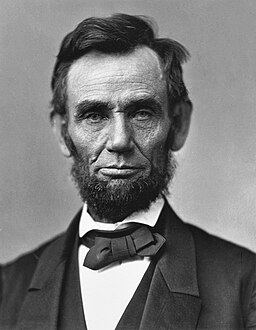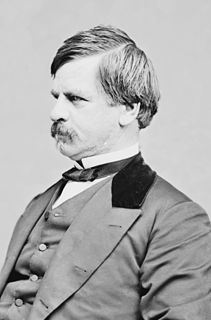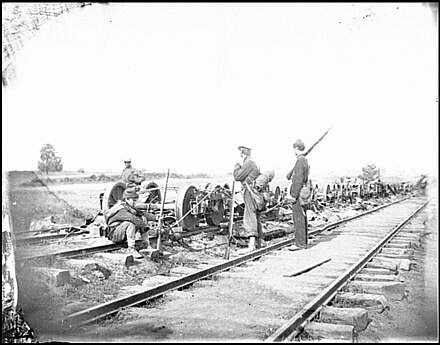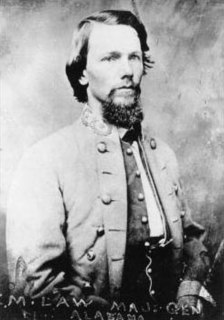

The Northern Virginia Campaign, also known as the Second Bull Run Campaign or Second Manassas Campaign, was a series of battles fought in Virginia during August and September 1862 in the Eastern Theater of the American Civil War. Confederate General Robert E. Lee followed up his successes of the Seven Days Battles in the Peninsula Campaign by moving north toward Washington, D.C., and defeating Maj. Gen. John Pope and his Army of Virginia.

Virginia, officially the Commonwealth of Virginia, is a state in the Southeastern and Mid-Atlantic regions of the United States located between the Atlantic Coast and the Appalachian Mountains. The geography and climate of the Commonwealth are shaped by the Blue Ridge Mountains and the Chesapeake Bay, which provide habitat for much of its flora and fauna. The capital of the Commonwealth is Richmond; Virginia Beach is the most populous city, and Fairfax County is the most populous political subdivision. The Commonwealth's estimated population as of 2018 is over 8.5 million.

The Eastern Theater of the American Civil War consists of the major military and naval operations in the states of Virginia, West Virginia, Maryland, and Pennsylvania, the District of Columbia, and the coastal fortifications and seaports of North Carolina.

The American Civil War was a civil war fought in the United States from 1861 to 1865, between the North and the South. The most studied and written about episode in U.S. history, the Civil War began primarily as a result of the long-standing controversy over the enslavement of black people. War broke out in April 1861 when secessionist forces attacked Fort Sumter in South Carolina shortly after Abraham Lincoln had been inaugurated as the President of the United States. The loyalists of the Union in the North proclaimed support for the Constitution. They faced secessionists of the Confederate States in the South, who advocated for states' rights to uphold slavery.
Contents
- Background
- Military situation
- Plans
- Initial movements
- Opposing forces
- Union
- Confederate
- Battles and movements
- Cedar Mountain
- Lee advances to the Rappahannock
- Skirmishing on the Rappahannock
- Raiding Manassas Station
- Thoroughfare Gap
- Second Bull Run (Manassas)
- Chantilly
- Aftermath
- Notes
- References
- Further reading
- External links
Concerned that Pope's army would combine forces with Maj. Gen. George B. McClellan's Army of the Potomac and overwhelm him, Lee sent Maj. Gen. Thomas J. "Stonewall" Jackson north to intercept Pope's advance toward Gordonsville. The two forces initially clashed at Cedar Mountain on August 9, a Confederate victory. Lee determined that McClellan's army on the Virginia Peninsula was no longer a threat to Richmond and sent most of the rest of his army, Maj. Gen. James Longstreet's command, following Jackson. Jackson conducted a wide-ranging maneuver around Pope's right flank, seizing the large supply depot in Pope's rear, at Manassas Junction, placing his force between Pope and Washington, D.C. Moving to a very defensible position near the battleground of the 1861 First Battle of Bull Run (First Manassas), Jackson successfully repulsed Union assaults on August 29 as Lee and Longstreet's command arrived on the battlefield. On August 30, Pope attacked again, but was surprised to be caught between attacks by Longstreet and Jackson, and was forced to withdraw with heavy losses. The campaign concluded with another flanking maneuver by Jackson, which Pope engaged at the Battle of Chantilly on September 1.

George Brinton McClellan was an American soldier, civil engineer, railroad executive, and politician. A graduate of West Point, McClellan served with distinction during the Mexican War (1846–1848), and later left the Army to work in railroads until the outbreak of the Civil War (1861–1865). Early in the war, McClellan was appointed to the rank of major general and played an important role in raising a well-trained and organized army, which would become the Army of the Potomac in the Eastern Theater; he served a brief period as general-in-chief of the Union Army. Although McClellan was meticulous in his planning and preparations, these very characteristics hampered his ability to challenge aggressive opponents in a fast-moving battlefield environment. He chronically overestimated the strength of enemy units and was reluctant to apply principles of mass, frequently leaving large portions of his army unengaged at decisive points.

The Army of the Potomac was the principal Union Army in the Eastern Theater of the American Civil War. It was created in July 1861 shortly after the First Battle of Bull Run and was disbanded in May 1865 following the surrender of the Confederate Army of Northern Virginia in April.

Thomas Jonathan "Stonewall" Jackson served as a Confederate general (1861–1863) during the American Civil War, and became one of the best-known Confederate commanders after General Robert E. Lee. Jackson played a prominent role in nearly all military engagements in the Eastern Theater of the war until his death, and played a key role in winning many significant battles.
Lee's maneuvering of the Army of Northern Virginia against Pope is considered a military masterpiece. Historian John J. Hennessy wrote that "Lee may have fought cleverer battles, but this was his greatest campaign." [4]

The Army of Northern Virginia was the primary military force of the Confederate States of America in the Eastern Theater of the American Civil War. It was also the primary command structure of the Department of Northern Virginia. It was most often arrayed against the Union Army of the Potomac.

























